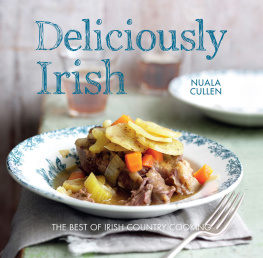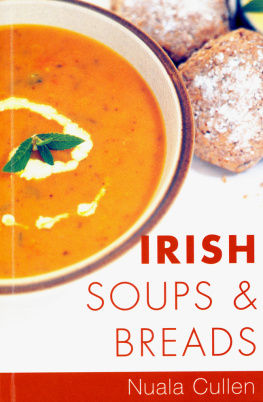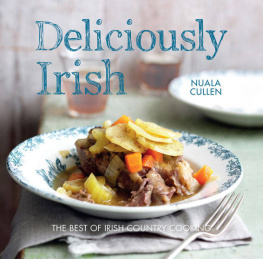

THE BEST OF IRISH COUNTRY COOKING
NUALA CULLEN
FOOD PHOTOGRAPHY BY TONY BRISCOE
LANDSCAPE PHOTOGRAPHY BY MICHAEL DIGGIN

Bluebells bloom in spring at Killarney National Park in County Kerry.
INTRODUCTION
The vision of ancient Celtic Ireland that has come down to us through folklore and poetry is of a land of plenty, where poetry and music were among the important occupations of the people, and honour and hospitality went hand in hand.
Through the centuries, hospitality continued to be a matter of honour, for rich and poor alike. Nearer to our own times, in the eighteenth and nineteenth centuries, successive travellers to Ireland invariably commented on the lavish welcome, the rich variety and quantity of food and the large numbers of persons entertained. The ill-fated dependence upon the potato by almost one-quarter of the population, however, and the tragic aftermath of the failure of the potato crop in the successive famines of the 1840s, is all too well known. Life changed profoundly for many people as a consequence, and the tradition of prodigal hospitality was almost swept away.
Ireland, however, is a natural food-producing country and, in recent decades, extensive research has produced an improved understanding of the best production methods for our food resources, creating a true land of plenty. Irish products are now in demand all over Europe. There has been a renaissance in Irish cooking, too: a new generation of Irish chefs, cosmopolitan in their training but with roots in their own tradition, are creating a discernibly Irish style of professional cooking, which allows the excellent raw materials to speak for themselves. We are also fortunate in Ireland that many of the festival days are still observed, even if only in perfunctory way. Such feast days obviously put the emphasis on seasonal ingredients, and the recipes included in this book aim to give an idea of some of the dishes that have been in common use in Ireland for many hundreds of years (with a few exceptions).
I hope that you will enjoy them and that they will contribute in some measure to the enjoyment of your guests and the conviviality of the dinner table, a pleasure as important in Ireland today as it has been for centuries.

The rolling hills of County Kerry.
STARTERS

Fishing boats at Dingle Peninsula in Lough Gill, County Kerry.
MUSSELS WITH BACON AND RED WINE

SERVES 6 AS A STARTER OR 4 AS A MAIN COURSE
Lord Smart (to Neverout): Tom, they say fish should swim thrice.
Neverout: How is that, my Lord?
Lord Smart: Why, Tom, first it should swim in the Sea (Do you mind me?), then it should swim in Butter; and at last Sirrah, it should swim in good Claret.
Jonathan Swift, Polite Conversation
2 litres/3 pints live mussels
240 ml/8 fl oz red wine
2 tablespoons butter
1 fresh thyme sprig
6 streaky bacon rashers, chopped
4 shallots
2 garlic cloves, finely chopped
3 large ripe tomatoes, de-seeded and chopped
1 tablespoon plain flour
2 tablespoons chopped fresh flat-leaved parsley, plus extra to garnish salt and freshly ground black pepper
fresh crusty bread, to serve
Clean the mussels thoroughly, discarding any that are broken or which dont close when sharply tapped, and put them in a large saucepan, with the wine. Cover, bring to the boil and cook for 2 minutes, shaking the pan from time to time, until the mussels are open. Remove the mussels to a bowl, discarding any that do not open. Strain the liquid carefully into a bowl, discarding any sand or grit.
Melt 1 tablespoon butter in a saucepan, add the thyme and bacon and cook until crisp. Then add the shallots and garlic and cook until soft. Add the tomatoes.
Blend the remaining butter and the flour together and stir into the saucepan, a piece at a time, stirring until the flour is cooked and the sauce is smooth. Add the mussel liquid gradually, stirring until the sauce has thickened. If it is too thick, add a little water. Reheat the mussels in the sauce for a few moments, then stir in the parsley. Check and adjust the seasoning. Garnish with parsley and serve with fresh crusty bread.
SOUSED HERRINGS
SERVES 46
The herring was once a staple of the Irish diet, and its seasonal reappearance was greeted with pleasure by rich and poor alike. Sousing, a simple way of preserving fish, became very popular in its own right. The sousing liquid here is a mild one, so if you like your herrings hot, leave them in the cold marinade for a few hours before cooking to develop the flavours.
810 herring fillets
810 shallots
23 bay leaves
1 onion, finely sliced
1 tablespoon chopped fresh parsley
small boiled potatoes, to serve
FOR THE MARINADE
300 ml/ pint cider or white wine vinegar
300 ml/ pint dry cider or white wine
2 teaspoons juniper berries, slightly crushed
tsp chilli powder or chopped fresh chillies, or to taste
12 tablespoons each of brown sugar, mustard seeds and black peppercorns
Boil the marinade ingredients together gently for a few minutes. Cool and allow to infuse for 30 minutes.
Preheat the oven to 150C/300F/Gas Mark 2. Lay out the fish fillets on a board and arrange a peeled shallot and a bay leaf on each half. Roll up and secure with a cocktail stick. Arrange in an ovenproof dish, scatter the onion slices over the top and pour the marinade into the dish. Cover with foil and bake for 3040 minutes.
Garnish with the parsley and serve with small boiled potatoes. To serve cold, cool before packing into a plastic box, which will allow the cooking liquid to cover them, and chill, overnight if possible. Serve with pickled onions or gherkins with mustard or horseradish sauce on the side. They will keep for 23 days in the fridge.
CODS ROE & CODS ROE PT
SERVES 4 AS A STARTER OR 2 AS A LUNCH DISH
The season for cods roe is very short, a mere 23 weeks between February and March, so it is important to make the most of it. The roes freeze well, either raw or cooked, so its a good idea to buy extra when they are available. Smaller roes are more delicate in texture, but the larger ones are very good, too.
To cook, simply tie the roe loosely in a plastic bag, cover with boiling water and simmer slowly for 1520 minutes, until it is firm to the touch. Leave to cool and remove from the bag. The simplest and most traditional preparation is to cut it into thick slices, dip in seasoned flour, or egg and breadcrumbs, and fry gently in a mixture of butter and oil until crisp. Very good indeed for breakfast, with crisp bacon and grilled tomatoes or mushrooms, or for lunch with creamy mashed potato and a slice of lemon.
Next page

















